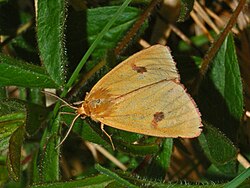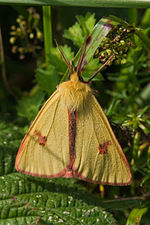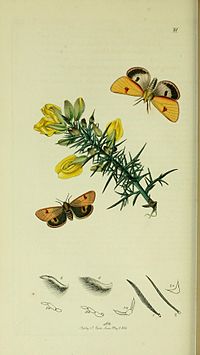zh-TW
在導航的名稱


Der Rotrandbär (Diacrisia sannio) ist ein Schmetterling (Nachtfalter) aus der Familie der Bärenspinner (Arctiinae).
Die Flügelspannweite beträgt etwa 25 Millimeter. Die Männchen sind auf der Oberseite hell gelb mit je einem roten Mittelfleck auf jedem Flügel gefärbt. Die Hinterflügel sind weiß mit einer z. T. in einzelne Punkte aufgelöste schwarze Querbinde am Außenrand. Vorder- und Hinterflügel sind mit Ausnahme des Hinterrandes des Hinterflügels rot gerandet. Die deutlich kleineren Weibchen haben orange Vorderflügel mit roten Punkten, während die Hinterflügel fast schwarz sind und einen roten Randbereich aufzeigen. Die Eier werden in Gruppen an den Blättern der Futterpflanzen der Raupen abgelegt. Das einzelne Ei ist gelblich-weiß und halbkugelig. Die Raupe ist schwarzbraun bis rötlichbraun behaart. Sie besitzt eine weißliche Mittellinie mit roten Punkten. Die Raupe überwintert und verpuppt sich im Frühjahr in einem Gespinst am Boden. Die glänzend rotbraune Puppe besitzt einen Kremaster mit Borsten.
Man findet den Rotrandbär auf Moorwiesen, Bruchwäldern, Flussauen, an Waldrändern, in Schonungen oder auf Waldlichtungen mit Grasbewuchs und Wiesen. Im Gebirge ist er bis zu einer Höhe von 2.400 Metern zu finden.
Der Rotrandbär fliegt je nach Region und Höhe in einer oder zwei Generationen. Bei einer Generation im Jahr findet man von Juni bis Juli die ausgewachsenen Schmetterlinge. Kommt es zu zwei Generationen fliegen die Falter der ersten Generation von Mai bis Juni. Die Falter der zweiten Generation sind dann von Juli bis August zu finden. Die Weibchen locken zur Paarungszeit die Männchen mit einem Sexuallockstoff an. Die Raupen der ersten Generation findet man von September bis Mai und die der zweiten Generation von Juli bis August. Die Falter sind tag- und nachtaktiv. Sie kommen ans Licht. Allerdings sind die Weibchen des Rotrandbären sehr flugträge. Die Raupen sind dagegen ausschließlich nachtaktiv. Die Raupe überwintert.
Die Raupen fressen unter anderem:
Die Falter fliegen von Juni bis Juli, die Raupen treten von August und nach der Überwinterung bis Mai auf.
Das Verbreitungsgebiet des Rotrandbären erstreckt sich über ganz Europa (im Norden bis zum 68. Breitengrad), über das nördliche Asien bis nach Japan.
Die Bestände des Rotrandbärs scheinen zumindest regional rückläufig zu sein. In einigen deutschen Bundesländern steht die Art deshalb auf der Vorwarnliste (Art ist bei weiterer Zerstörung des Lebensraumes in Zukunft gefährdet) oder wird bereits als gefährdet eingestuft.
Der Rotrandbär (Diacrisia sannio) ist ein Schmetterling (Nachtfalter) aus der Familie der Bärenspinner (Arctiinae).
Diacrisia sannio, the clouded buff, is a moth of the family Erebidae. The species was first described by Carl Linnaeus in his 1758 10th edition of Systema Naturae. It is found in the Palearctic realm from Ireland to Siberia. It is not found in North Africa. In the Russian Far East (Amur, Primorye, Sakhalin, Kunashir), eastern China, Korea, and Japan it is replaced by Diacrisia irene.
The wingspan is 35–50 mm. The forewing of the male is lemon yellow, and the hindwing is ivory yellow, both wings with a greyish red median spot and pink margin. In the female the body and wings are suffused with brownish red. In pallida Stgr., which occurs constantly in Central Asia and aberratively also in Europe, the black colour is reduced. In irene Butl. (now full species Diacrisia irene Butler, 1881), which occurs in Japan and locally also elsewhere in the Palearctic region, and is regarded by Matsumura as a separate species, the black colour is absent on the hindwing of the male and the median spot on the forewing is generally reduced. In uniformis Stgr. (D. s. mortua (Staudinger, 1887)) from Syr-Darja, the last trace of black and pink has disappeared, so that extreme specimens of this form are quite uniformly pale yellow on both sides of the wings and body. In specimens from Ferghana, the Issyk-kul and the neighbouring countries further east in Central Asia, the red inner margin of the forewing is entirely absent, the black on the hindwing being however present. This is the form mortua Stgr. (D. s. mortua (Staudinger, 1887)). Further eastward, at the Amur, a form occurs with very sharp black markings, and with the ground colour of the hindwing strongly tinged with reddish, amuri Butler, 1881 Stgr.[1]
The moth flies June to July depending on the location.
Larva dark brown, with foxy red hairs, light dorsal line spotted with red, and white stigmata. The larvae feed on various shrubs and herbaceous plants. Species in the genera Galium, Plantago, Taraxacum, Epilobium and Urtica.
Diacrisia sannio, the clouded buff, is a moth of the family Erebidae. The species was first described by Carl Linnaeus in his 1758 10th edition of Systema Naturae. It is found in the Palearctic realm from Ireland to Siberia. It is not found in North Africa. In the Russian Far East (Amur, Primorye, Sakhalin, Kunashir), eastern China, Korea, and Japan it is replaced by Diacrisia irene.


 Illustration from John Curtis's British Entomology Volume 5
Illustration from John Curtis's British Entomology Volume 5
La escama de borde ensangrentado (Diacrisia sannio) es una especie de lepidóptero ditrisio de la familia Erebidae, que se encuentra en toda Europa hasta los 68ºN y en Asia.[1]
Tiene una envergadura de 35–50 mm. Las alas anteriores del macho son amarillo limón con una mancha más oscura en el centro.
La larva se alimenta de Galium, Plantago, Taraxacum, Epilobium y Urtica.
La escama de borde ensangrentado (Diacrisia sannio) es una especie de lepidóptero ditrisio de la familia Erebidae, que se encuentra en toda Europa hasta los 68ºN y en Asia.
Tiene una envergadura de 35–50 mm. Las alas anteriores del macho son amarillo limón con una mancha más oscura en el centro.
La larva se alimenta de Galium, Plantago, Taraxacum, Epilobium y Urtica.
Bordure ensanglantée, Roussette
La Bordure ensanglantée ou la Roussette (Diacrisia sannio) est une espèce paléarctique de lépidoptères (papillons) de la famille des Erebidae et de la sous-famille des Arctiinae.
L'espèce est répandue en Eurasie[1], y compris dans toute la France métropolitaine[2].
Prairies humides, forêts marécageuses mais aussi pentes sèches, clairières, coupes et lisières. Chenille sur de nombreuses plantes basses[3].
Vol d'avril à août selon la localisation. Le mâle vole le jour, la femelle est plutôt nocturne[4].
Bordure ensanglantée, Roussette
La Bordure ensanglantée ou la Roussette (Diacrisia sannio) est une espèce paléarctique de lépidoptères (papillons) de la famille des Erebidae et de la sous-famille des Arctiinae.
Diacrisia sannio é uma espécie de insetos lepidópteros, mais especificamente de traças, pertencente à família Erebidae.[1]
A autoridade científica da espécie é Linnaeus, tendo sido descrita no ano de 1758.
Trata-se de uma espécie presente no território português.
Diacrisia sannio é uma espécie de insetos lepidópteros, mais especificamente de traças, pertencente à família Erebidae.
A autoridade científica da espécie é Linnaeus, tendo sido descrita no ano de 1758.
Trata-se de uma espécie presente no território português.